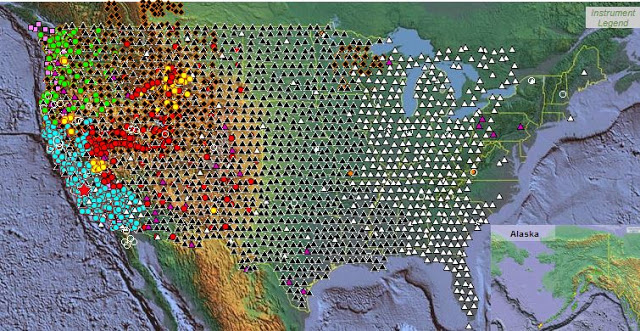

| Visitors Now: | |
| Total Visits: | |
| Total Stories: |

| Story Views | |
| Now: | |
| Last Hour: | |
| Last 24 Hours: | |
| Total: | |
Incoming! Then Outgoing! Waves Generated By Russian Meteor Recorded Crossing The U.S.
The National Science Foundation- (NSF) supported stations are used to study earthquakes and the Earth’s deep interior.
Meteor trail over eastern Russia is seen in this image from the Russian Emergency Ministry.
Credit: Russian Emergency Ministry
While thousands of earthquakes around the globe are recorded by seismometers in these stations–part of the permanent Global Seismographic Network (GSN) and EarthScope’s temporary Transportable Array (TA)–signals from large meteor impacts are far less common.
The meteor explosion near Chelyabinsk on Feb. 15, 2013, generated ground motions and air pressure waves in the atmosphere. The stations picked up the signals with seismometers and air pressure sensors.
The ground motions were recorded by the GSN and the TA. The pressure waves were detected by special sensors that are part of the TA.

Credit: Wikimedia Commons
“The NSF-supported Global Seismic Network and EarthScope Transportable Array made spectacular recordings of the Chelyabinsk meteor’s impact,” says Greg Anderson, program director in NSF’s Division of Earth Sciences.
“These recordings of seismic waves through the Earth, and sound waves through the atmosphere, are good examples of how these facilities can help global organizations better monitor earthquakes, clandestine nuclear tests and other threats.”
Incoming! Then outgoing!
The Chelyabinsk meteor exploded in the atmosphere at approximately 9.20 a.m. local time.
The blast caused significant damage in the city, breaking thousands of windows and injuring more than 1,000 people.
Energy from the blast created pressure waves in the atmosphere that moved rapidly outward and around the globe. The blast also spread within the Earth as a seismic wave.

Credit: Russian Emergency Ministry
The two wave types–seismic wave and pressure wave–travel at very different speeds.
Waves in the ground travel quickly, at about 3.4 kilometers per second. Waves in the atmosphere are much slower, moving at about 0.3 kilometers per second, and can travel great distances.
GSN stations in Russia and Kazakhstan show the ground-traveling wave as a strong, abrupt pulse with a duration of about 30 seconds.
The atmospheric waves–referred to as infrasound–were detected across a range of inaudible frequencies and were observed at great distances on infrasound microphones.

Credit: IRIS
When the infrasound waves reached the eastern United States–after traveling 8.5 hours through the atmosphere across the Arctic from the impact site in Russia–they were recorded at TA stations at the Canadian border.
The infrasound waves reached Florida three hours later, nearly 12 hours after the blast.
Infrasound sensors at TA stations along the Pacific coast and in Alaska also recorded the blast, but with signatures that were shorter and simpler than those recorded by stations in the mid-continent and along the southeastern seaboard.

Credit: Wikimedia Commons
The duration of the signals, and the differences between the waveforms in the east and west, scientists believe, are related to the way in which energy travels and bounces on its long path through the atmosphere.
EarthScope Transportable Array
The Transportable Array is operated by the IRIS (Incorporated Research Institutions for Seismology) Consortium as part of NSF’s EarthScope Project. It consists of 400 stations traversing the United States, recording at each site along the way for two years.
Each of the TA stations was originally equipped with sensitive broadband seismometers for measuring ground motions, but in 2010, NSF awarded the University of California, San Diego, in cooperation with IRIS, funding to add pressure and infrasound sensors.
These special sensors help scientists understand how changes in pressure affect ground motions recorded by the TA’s seismometers and provide a view of regional pressure changes related to weather patterns.
The sensors also record events such as tornadoes, derechos, rocket launches, chemical explosions–and meteor impacts.
The Chelyabinsk meteor is the largest signal recorded to date.
In 2013, the Transportable Array will reach states in the Northeast, completing its traverse of the contiguous United States and southern Canada.
Global Seismographic Network
The GSN’s primary mission is collecting data to monitor worldwide earthquakes and to study the Earth’s deep interior.
It’s funded jointly by NSF and the U.S. Geological Survey and is managed and operated by IRIS in collaboration with the U.S. Geological Survey’s Albuquerque Seismological Laboratory and the University of California, San Diego.
As part of a worldwide network of seismic stations, data from the GSN have contributed over the past three decades to the monitoring of nuclear explosions at test sites in the United States, the former Soviet Union, India, Pakistan and Korea. For example, GSN stations provided observations of the Korean nuclear test on Feb. 12, 2013.
|
||
2013-03-05 13:00:55
Source: http://nanopatentsandinnovations.blogspot.com/2013/03/incoming-then-outgoing-waves-generated.html
Source:





to arthur. good article very informative this time and ur right that meteor caused are globe to Act up even More across are world. heres some proof for Your deniers my brother today in san antonio tx the winds were as fierce as a tempest awakening. gusting causeing power outages at multiple places in san antonio at a time also there are red wind advisoryes here in my home town blowing trees down like a toothpick look it up on ksat.com peace predictability.